St Andrew's Hospital
Devons Road, Bromley-by-Bow, E3 3NT
Medical dates:
Medical character:
1871 - 2006
Acute. Later, geriatric
The Poplar and Stepney Sick Asylum with 572 beds opened in
1871 on a site directly south and adjacent to the Stepney workhouse.
The buildings were erected at a cost of £43,000. They
followed the pavilion system of separate blocks connected to each other
by corridors and bridges. A central administrative block
contained the nurses' rooms, the Board Room, offices and a chapel, with
the kitchens and laundry rooms at the rear. On either side of
this central block were two three-storey ward blocks - male patients in
the western ones and female patients in the eastern.
The Asylum was one of only two public hospitals built by the
Metropolitan Asylums Board (M.A.B.), the other being for the Central
London Asylum District at Colindale.
The intention had been to have a major hospital in each of the
six Sick Asylum Districts - the first attempt at London-wide planning
for health provision - but the costs were found to be prohibitive.
Although certified to have 26 nursing staff, in the first year of its
opening the Asylum had one doctor and no trained nurses. Of the
2094 patients admitted, 282 (about 13%) died. A Medical
Superintendent was appointed in 1872.
A School of Nursing was established at the Asylum in 1875, offering a three-year training course.
Further ward blocks were added on the eastern part of the site in 1892.
Further extension in 1895 increased the bed total to 770. A
Nurses' Home was erected in 1896 at the southwest corner of the site.
In 1908 the Asylum was embroiled in a scandal, when six members of the
Board of Guardians were found guilty of conspiracy to defraud; they had
been accepting overpriced tenders for building work, the builder then
handing over money to the conspirators.
During WW1 Royal Army Medical Corps personnel received training as
nursing orderlies at the Asylum and, later, one of the pavilions was
given over for military medical use.
In 1920 it was renamed St Andrew's Hospital, after a local church which had been destroyed during the war.
The Poplar and Stepney Sick Asylum District was abolished in 1925 and
the Hospital administration transferred to M.A.B. In 1929 new
maternity wards were opened and an optional maternity training course
for nursing staff was established.
By 1930 the Hospital had 395 beds for the chronic sick.
In 1933 the LCC took over its administration.
In 1948 the Hospital joined the NHS and came under the Bow Hospital Management Committee, which included the Poplar and St Clement's Hospitals. In 1963 the Committee was merged with the West Ham Group to form the Thames Group of Hospitals.
From 1974 until 1982 it was part of the Newham Health District under
the management of the City and East London Area Health Authority, then
transferring to Newham Health Authority.
A new Accident and Emergency Department opened in the early 1980s at
the Devas Street end of the site. Following the closure of the Newham Maternity Hospital in Forest Gate in 1985, the headquarters of the Newham District School of Nursing transferred to St Andrew's.
In 1990 the Hospital had 283 beds, but a systematic reduction of
services had begun. Eighty-five percent of the Hospital buildings
were considered to be in poor condition and below acceptable standards
for clinical use. The Out-Patients Department closed, as well as
some wards. Patients were transferred to Newham General Hospital.
The Devons Road entrance to the Hospital was closed. The
Intensive Treatment Unit closed in 1995, as well as the Accident &
Emergency Department (but a Receiving Room was retained so that GPs
could refer patients with medical or surgical problems; this closed in
1999).
The remaining services concentrated on rehabilitation and geriatric care.
The Pathology Laboratories closed in 2001. It had been intended
that the site would be vacated by 2004, but St Andrew's finally emptied
of patients in 2006.
| Present status (February 2008) The 3 hectare site is being redeveloped by Barratt Homes to provide 800 dwellings. By February 2008 about 50% of the buildings had been demolished. |
|---|
N.B. Photographs obtained in February 2008.
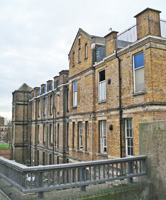
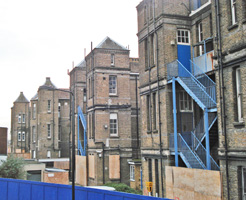
The ward blocks at the northeast, next to Bromley-by-Bow station, awaiting demolition.
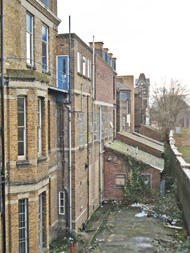
The east side of the site.

The southeast corner (above and below).
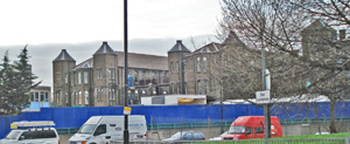
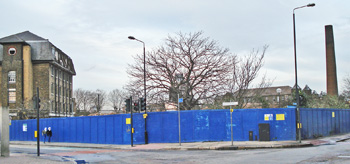
The southwest corner at Devons Road and Devas Street.
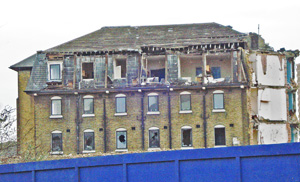
A partly demolished building on the southwest corner - probably the former Nurses' Home.
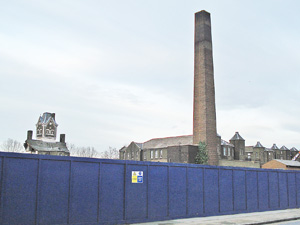
The clock tower and chimney as seen from Devas Street in the south.
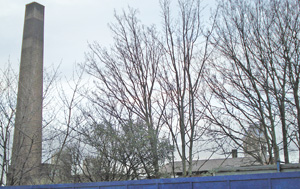
The south side from Devas Street.
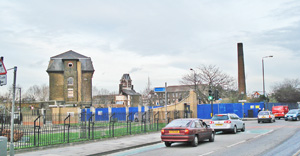
The few remaining features as seen from Devons Road.
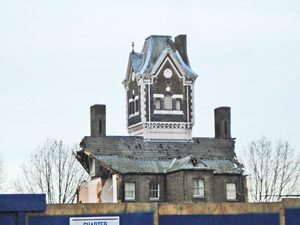
The clock tower of the central administration building on the north side.
Update: October 2010
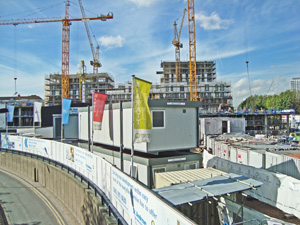
The Hospital has been demolished and construction is underway.
Update: April 2011
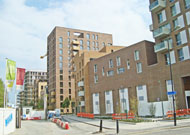
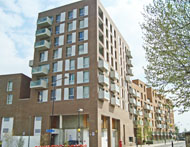
The western part of the redevelopment on Devons Road and along half of Devas Street has been completed.

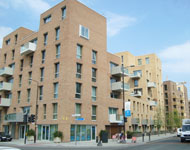
The apartment blocks along the western half of Devas Street (left), with a new entrance drive (right).
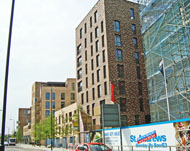
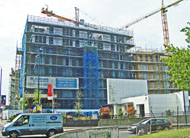
Work is still progressing along the eastern part of the site.
Update: June 2013
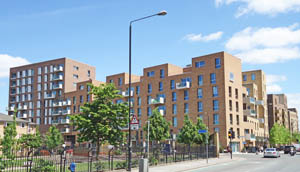
The western side of the St Andrews development on Devons Road.
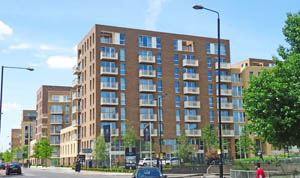
New apartment blocks along Devas Street.
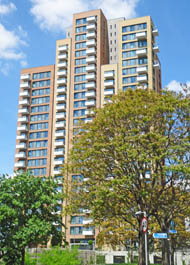
The Plaza at the eastern side of the site.
References (Accessed 20th November 2015)
Hacker E 1971 A Short History of St Andrew's Hospital, Bromley-by-Bow, 1871-1971. London, The Hospital.
http://discovery.nationalarchives.gov.uk